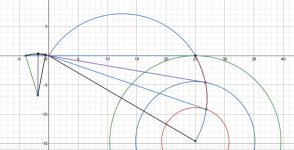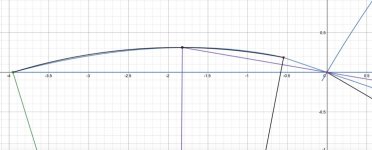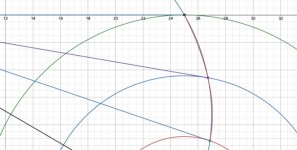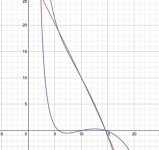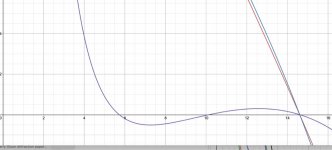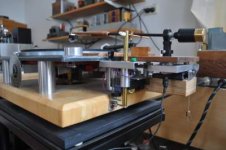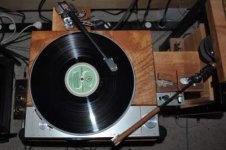A tangential tracking pivoting tonearm #6
Here is the data for tonearm nominal effective length 25 cm at the outer groove. The maximum tracking error is 0.5 degrees and is less than 0.3 degrees for 70% of the grooved area. The maximum extension of the tonearm is 3.38 cm, which will mean a much smaller increase in stylus downforce with tonearm extension. I would doubt that any cartridge manufacturer has a guaranteed cantilever alignment to better than 0.3 degrees. Therefore in principle, the theoretical lateral tracking error is effectively state of the art.
As always, implementation is the key.
Here is the data for tonearm nominal effective length 25 cm at the outer groove. The maximum tracking error is 0.5 degrees and is less than 0.3 degrees for 70% of the grooved area. The maximum extension of the tonearm is 3.38 cm, which will mean a much smaller increase in stylus downforce with tonearm extension. I would doubt that any cartridge manufacturer has a guaranteed cantilever alignment to better than 0.3 degrees. Therefore in principle, the theoretical lateral tracking error is effectively state of the art.
As always, implementation is the key.
Attachments
The tonearm will experience no side thrust and hence will require no anti skating device.
Hello Bon,
Any tone arm that incorporates cams, links and levers to the LEFT of its pivot, will be subject to the inward force. The fact that the head shell center line is coaxial with the center line of the tone arm tube, has nothing to do with it.
One of your videos actually shows the arm skating in the absence of a grooved record.
Sincerely,
Ralf
I am thinking that maybe an air bearing slider may give the required low friction.
Hello Bon,
An air bearing requires a compressor driven by an electric current. In order to keep the air pressure constant, a buffer tank is required. In order to keep the tank under pressure, a pressure switch is also required. You now have a servo to make your tone arm work. It is an external servo but a servo nevertheless.
Sincerely,
Ralf
Any tone arm that incorporates cams, links and levers to the LEFT of its pivot, will be subject to the inward force.
One of your videos actually shows the arm skating in the absence of a grooved record.
Hi Ralf. I beg to differ.
In the attached video link, the turntable is started with the tonearm on the tangential path (roller axis pointing directly at the centre spindle)
There is no sideways movement. Because of the play in the pivots it is possible to lift the tonearm and move it slightly off the tangential path. To the rear of the tangential path (opposite to the direction of rotation), the tonearm experiences an outward skating force. Placed ahead of the tangential path (the direction of rotation), the tonearm experiences an inward skating force.The tonearm moves until it re-establishes a tangential position. Of course with a stylus in a groove it would just apply side thrust to the groove.
The direction of the skating forces are easily felt through the fingers when re-positioning the tonearm in each case.
It clearly shows that the skating force can be outward, inward or zero. The tangential path is a zero side force configuration. Of course the circular rear strut only provides a very good approximation to true tangential tracking, and the side force will be zero only at the three reference radii. Elsewhere in the playing area, the side force generated is small enough to be considered negligible.
Tangential tonearm skating #2 - YouTube
Hello Bon,
As I understand your proposed tone arm, it can only move in a forward direction. If you were to play an eccentric record, the cantilever would be deflected outwardly once per revolution, because the tone arm cannot move backwards.
Sincerely,
Ralf
See the video in my previous post.
The sliding bearing can move in either direction.
Hi Ralf.Hello Bon,
An air bearing requires a compressor driven by an electric current. In order to keep the air pressure constant, a buffer tank is required. In order to keep the tank under pressure, a pressure switch is also required. You now have a servo to make your tone arm work. It is an external servo but a servo nevertheless.
Sincerely,
Ralf
It was only a brief speculation on how to implement a very low friction sliding bearing. No real enthusiasm for such complication. I have a few purely passive options to explore. I am optimistic so far.
Hi Bon,
I looked at video #4. My question is why the arm stopped at the middle of the platter. Is it possible that the arm had a slight overhang at the beginning? So, the skating force drove the arm inwards until the arm was tangential to the groove. In the meantime, the overhang was zero.
I did some skating force tests in 2013. I found that if overhang exists, the arm will skate inwards and if underhang exists, the arm will skate outwards. If the arm is stationary, it means the arm is tangential to groove and has no skating. Neither overhang nor underhang exists.
I saw Wally Tools posted some skating force test videos recently. Their tests are the same as mine.
Skating Force - A Video Demonstration
Jim
I looked at video #4. My question is why the arm stopped at the middle of the platter. Is it possible that the arm had a slight overhang at the beginning? So, the skating force drove the arm inwards until the arm was tangential to the groove. In the meantime, the overhang was zero.
I did some skating force tests in 2013. I found that if overhang exists, the arm will skate inwards and if underhang exists, the arm will skate outwards. If the arm is stationary, it means the arm is tangential to groove and has no skating. Neither overhang nor underhang exists.
I saw Wally Tools posted some skating force test videos recently. Their tests are the same as mine.
Skating Force - A Video Demonstration
Jim
Last edited:
An air bearing requires a compressor driven by an electric current. ....You now have a servo to make your tone arm work.....
I don't know if you are seriously dissing for use of a servo, but--
There are ways to get steady pressure without a servo and/or without electric current. Engine-driven air compressors are a thing, if not welcome here. A fall of water can drive an air-trap and compress air, a "trompe"; this has been done at industrial scale. You can simply run your whatever air pump constantly and blow-off the excess with a weighted valve. Medieval church organs did not rely on the judgement of the bellows-workers but had a bellows-box with selected bricks on top and a port or trip-valve to waste air if the bellows maxxed-out.
no servo foe
You and others might not be aware that Straight Tracker/Ralf is a regular on these threads about tangential tracking tonearms. In his own tonearm invention, he himself employs servo. Check out his own forum thread and a video demonstrating his amazing invention. Basically, Ralf is a friend of servo.
I don't know if you are seriously dissing for use of a servo
You and others might not be aware that Straight Tracker/Ralf is a regular on these threads about tangential tracking tonearms. In his own tonearm invention, he himself employs servo. Check out his own forum thread and a video demonstrating his amazing invention. Basically, Ralf is a friend of servo.
Last edited:
Did you say “roller”??What is important to note is that the axial bolt of the roller that replaces the role of a stylus,
Did you say “roller” again??In the attached video link, the turntable is started with the tonearm on the tangential path (roller axis pointing directly at the centre spindle)
The presence of a roller in place of a ‘stylus’ is obfuscating the forces at play here and leading to erroneous conclusions being drawn from the video observations. A roller instead of a friction point is making the arm pivot and sliding bearings the dominant source of friction in the system, whereas you posit in post #7 that stylus friction will be the sole source of energy driving this non-servo system and the pivot & sliding bearings will be of ‘impeccable performance’, implying negligible friction. By artificially removing the “stylus” drag force from the test by using a roller, we then observe the arm in the videos exhibit some self-aligning behavior, which might further lead one to conclude that there is no skating force. The self-aligning behavior is, most certainly, being facilitated by friction/stiction in the sliding bearing together with slop in all the bearings.
Please repeat this test without the roller by using some type of ‘drag point’ to simulate the frictional drag of a stylus. This will simulate the condition wherein the stylus drag will be the most significant friction source in an otherwise friction-free system that you described in post #7. By approximating the ‘stylus’ drag friction with the roller gone and pivot/sliding friction in a more realistic proportion you will begin to see that the arm will skate, for the reasons outlined by Straight Tracker in post #22.
In both of the post #5 and post #25 videos you are conspicuously manipulating the arm by pushing or pulling it axially as you move it across the record, instead of just moving it sideways and letting the mechanism adjust itself axially to follow your lateral motion. I hope this was unintentional, as it would appear to introduce bias (no pun intended) into the observed test results.
Lastly,
Have you performed a “string test”?
Ray K
Hello Bon,
As I understand your proposed tone arm, it can only move in a forward direction. If you were to play an eccentric record, the cantilever would be deflected outwardly once per revolution, because the tone arm cannot move backwards.
Sincerely,
Ralf
Ralf,
I believe that, strictly speaking and with theoretically perfect friction free bearings, the arm could also move in the backward direction. In the forward direction the stylus friction drag and resultant skating force aids arm movement and encourages it to move forward. In the backward direction though, there is still the stylus friction drag and resultant skating force driving the arm toward the spindle, but if you introduce anti-skate force plus/or additional left-side groove wall force (if the stylus cantilever suspension can tolerate it), then the arm will retreat backward and toward the right as the disk eccentricity swings outward.
As a practical matter, with real world friction/stiction conditions, I agree that this arm design has an intrinsic tendency to be a one-way ticket.
Ray K
Hi Bon,
I looked at video #4. My question is why the arm stopped at the middle of the platter. Is it possible that the arm had a slight overhang at the beginning? So, the skating force drove the arm inwards until the arm was tangential to the groove. In the meantime, the overhang was zero.
I did some skating force tests in 2013. I found that if overhang exists, the arm will skate inwards and if underhang exists, the arm will skate outwards. If the arm is stationary, it means the arm is tangential to groove and has no skating. Neither overhang nor underhang exists.
I saw Wally Tools posted some skating force test videos recently. Their tests are the same as mine.
Skating Force - A Video Demonstration
Jim
Hi Jim.
We agree exactly. I demonstrate this repeatedly in the video of post #25. The main difference with the tangential tracking sliding pivot tonearm is that the sidethrust attempts to re-establish tangency when placed in an overhang or underhand position. In a real groove where the stylus is constrained, the tonearm will get longer or shorter. Because of the very small difference between the perfect tangential path and the rear strut induced path, the difference in arm length will be negligible.
The performance with seriously off centre or eccentric discs, will be unknown until a prototype is built and teated.
Did you say “roller”??
Did you say “roller” again??
Please repeat this test without the roller by using some type of ‘drag point’ to simulate the frictional drag of a stylus.
This test will be coming up.
In both of the post #5 and post #25 videos you are conspicuously manipulating the arm by pushing or pulling it axially as you move it across the record, instead of just moving it sideways and letting the mechanism adjust itself axially to follow your lateral motion. I hope this was unintentional, as it would appear to introduce bias (no pun intended) into the observed test results.
The manipulation was deliberate to clearly show the effect of side force changing direction depending on over or underhang.
Lastly,
Have you performed a “string test”?
Ray K
I have seen this referred to but have not investigated what it is and its relevance. I will take some time to look at it.
Last edited:
My father in law's Micro Seiki 777 has an air pump with an irritating hum to float the 10kg platter on an air bearing. I'll suggest he enquires if Micro Seiki have a medieval serf option.Medieval church organs did not rely on the judgement of the bellows-workers but had a bellows-box with selected bricks on top and a port or trip-valve to waste air if the bellows maxxed-out.
Hi diyrayk.This test will be coming up.
In the latest and future videos, I will be using the 25 cm version of the working model. It will be more typical of what I will be aiming for in a prototype.
When I ran the numbers, I maintained a higher precision, instead of rounding. The results came out spot on with the theoretical modelling.
In the video, I replaced the rubber mat with a carbon fibre/stainless steel mat that has a surface more consistent with vinyl (minus the grooves).
The roller is intentionally jammed with a blob of blu-tack. It does not rotate. The sound of it sliding is very obvious.
Contrary to recent assertions, it makes no difference to the (non) skating behaviour of the tonearm. With the tonearm in a tangential orientation, it remains fixed since the friction forces, reaction forces, tonearm are aligned. Any prototype tonearm has no freedom to deviate from (near) tangential tracking and is expected to perform identically.
Tangential tonearm/sliding contact - YouTube
Hi Bon, If you put the needle down in the groove where it is not in tangent does the pivot point move so that the tangent is restored? If so you have found the Holy Grail.
Does it stay in tangent if once placed in position? ie Does it have any stability?
I think the needle needs three travel constraints to triangulate position and you have only two: the record groove and the pivot locus.
Frank Schroeder has a patent on something like this, but I havn't seen it. I suspect it uses a third magnetic 'rail' to stay on tangent but I don't know.
I made a pivoted tangential tracker where the pivot point moves 1" towards the centre of the platter. I used a clock to feed it out, with a cam to linearise the non linearity of the locus. I measured a bunch of records and took a standard deviation to approximate pitch.
Does it stay in tangent if once placed in position? ie Does it have any stability?
I think the needle needs three travel constraints to triangulate position and you have only two: the record groove and the pivot locus.
Frank Schroeder has a patent on something like this, but I havn't seen it. I suspect it uses a third magnetic 'rail' to stay on tangent but I don't know.
I made a pivoted tangential tracker where the pivot point moves 1" towards the centre of the platter. I used a clock to feed it out, with a cam to linearise the non linearity of the locus. I measured a bunch of records and took a standard deviation to approximate pitch.
Attachments
The presence of a roller in place of a ‘stylus’ is obfuscating the forces at play here
Please repeat this test without the roller by using some type of ‘drag point’ to simulate the frictional drag of a stylus.
Hi diyrayk.
I responded to your comments by re-doing the videos to address your concern that a rolling contact invalidates the results. I showed that the skating behaviour is the same (post #37)
Here are some observations on the arguments you presented:
Firstly a rolling frictional contact is not minimising the forward propulsive drag on the tonearm. Rolling frictional drag is precisely what allows your car to propel itself forward. The same is true for all wheeled vehicles. Without this rolling friction you are skating on ice, going nowhere. Whether the the car tyre is moving and the road stationary or the car tyre is stationary and the road is moving (like on a dyno, analogous to the roller and platter), the frictional forces are the same. There is no obfuscating of forces in my original videos.
Secondly, the self aligning behaviour is shown to be intrinsic to the tangential configuration. Slight mis-alignment of the front end will cause underhang or overhang and the resulting non-zero sideforce will move the tonearm inwards or outwards until tangency is re-established.
In a conventional offset pivoted tonearm on non-grooved disc, with no anti-skating applied, the non-tangency sideforce would similarly move the tonearm to a tangency position, (there are two such for typical offset). Since the proposed tonearm can vary in effective length, every position will exhibit (near) tangency.
Regards
Bon
In a conventional offset pivoted tonearm on non-grooved disc, with no anti-skating applied, the non-tangency sideforce would similarly move the tonearm to a tangency position
Are you saying all pivoting, offset tonearms will stop on the null points? If so, which one, and what happens to the skate force at the null points?
- Home
- Source & Line
- Analogue Source
- A tangential tracking pivoting tonearm
